Tethered Cord Due to Spina Bifida Occulta Presenting in Adulthood a Tricenter Review of 61 Patients
- Research
- Open Admission
- Published:
Tethered cord syndrome: surgical outcome of 43 cases and review of literatures
Egyptian Journal of Neurosurgery book 34, Article number:4 (2019) Cite this commodity
Abstract
Objective
To evaluate the surgical treatment of tethered string syndrome (TCS), a prospective assay of 43 patients operated at Neurosurgery Department Zagazig University hospitals from May 2013 to Jan 2017 with ane yr follow-up had been washed.
Patients and methods
Developed and children patients with tethered string syndrome subjected to microscopic surgeries for release of cord and nerves tethering with exclusion of primary repair of meningiomyelocele, paraplegic patients, hydrocephalic patients, and ages below 2 years sometime. Magnetic resonance imaging (MRI) of the spine was done for all patients and urodynamic studies for patients more than half-dozen years old preoperative and postoperative after 1 yr of surgery.
Results
Ten patients were adults > 18 years old and male person to female ratio was about 2:one. All patients presented with multiple clinical manifestations which either improved or stable during follow-upwards after surgery. Controllable complications occurred: cerebrospinal fluid (CSF) leak in 18.6% and wound infection in 4.7%. Urodynamic studies improved in 73% of patients after surgery and children showed significant improvement in all symptoms except back pain than developed patients.
Conclusion
Microscopic surgery is of value for patients suffering tethered cord syndrome with low risk of complications.
Introduction
Tethered string syndrome (TCS) is a stretch-induced functional disorder of the spinal cord with its caudal part anchored by an inelastic structure. The accustomed cause of TCS is spinal string traction, which leads to anatomic and metabolic disorders that are responsible for the clinical presentation. Fixation of the spinal cord can occur congenitally (primary TCS) or in association with other intra-spinal pathologies or postoperative scarring (secondary TCS). Most cases are related to spinal dysraphism [ane]. The age at presentation of TCS ranges from early childhood to the 80s. The symptoms related to a built tethered string occur most commonly in childhood, simply in many patients, the diagnosis is not established until adulthood. The presentation may also differ according to the underlying pathology, with back and leg hurting, cutaneous signs, orthopedic deformities, muscle weakness, urinary dysfunction, and neurological deficits being the most mutual. Other manifestations include gait deterioration, foot deformities, progressive scoliosis, and sphincter incontinence. Young children may have skeletal growth deformities, such equally a leg length discrepancy. Adolescent or young adult patients frequently complain of unexplained long-term back pain [two].
Decisions about treatment for tethered cord syndrome are complicated. One time the diagnosis established or when at that place is an established likelihood that tethered cord syndrome is evolving, the neurosurgeon is required to choose among treatment alternatives that volition assistance patients to maintain normal lives while minimizing surgical risks [1].
In this work, we presented a written report of 43 patients with tethered cord syndrome to evaluate the clinical presentation, imaging findings of such cases, and results of surgical treatment.
Patients and methods
Forty-three patients with tethered cord syndrome, 29 males and fourteen females with ages from two to 23 years old, were operated at Neurosurgery Department Zagazig University Infirmary from May 2013 to January 2017 later on approval from the Zagazig University Institutional review board (Zu-IRB). On admission, a written consent was taken for the procedure of untethering under full general anesthesia by microscopic surgery. All patients were evaluated for full general and neurological condition by clinical, laboratory, and imaging test. Preoperative MRI of the spine was done for all patients, and urodynamic studies were done for patients more than than 6 years erstwhile. Clinical evaluation had been done till hospital discharge and so after 3, 6, and 12 months. Urodynamic studies and MRI of the spine repeated after one year of surgery. All patients were subjected to microscopic surgeries for untethering under full general anesthesia for releasing tethering elements and repair of the thecal sac. Patients included in this study were diagnosed with tethered cord syndrome clinically and by imaging with exclusion of primary repair of meningiomyelocele, paraplegic patients, hydrocephalic patients, and ages below ii years old. Data collected throughout preoperative and postoperative examination and investigations were analyzed and submitted to statistical procedures using statistical packages for social science (SPSS) version 20. P value was fix at < 0.05 for significant results (Figs. one, ii, 3, four, and 5).
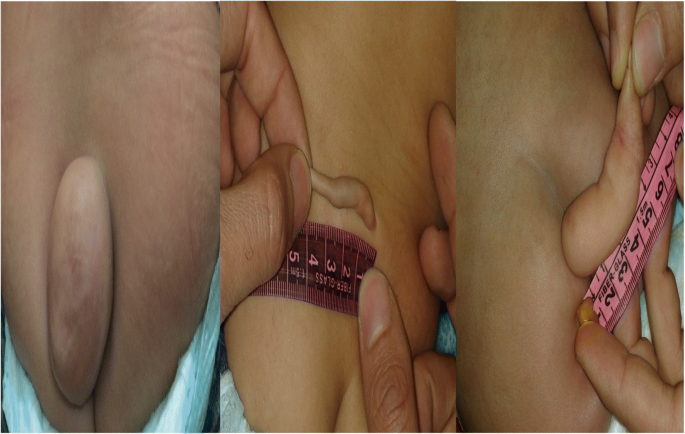
Different human tails associated with tethered cord
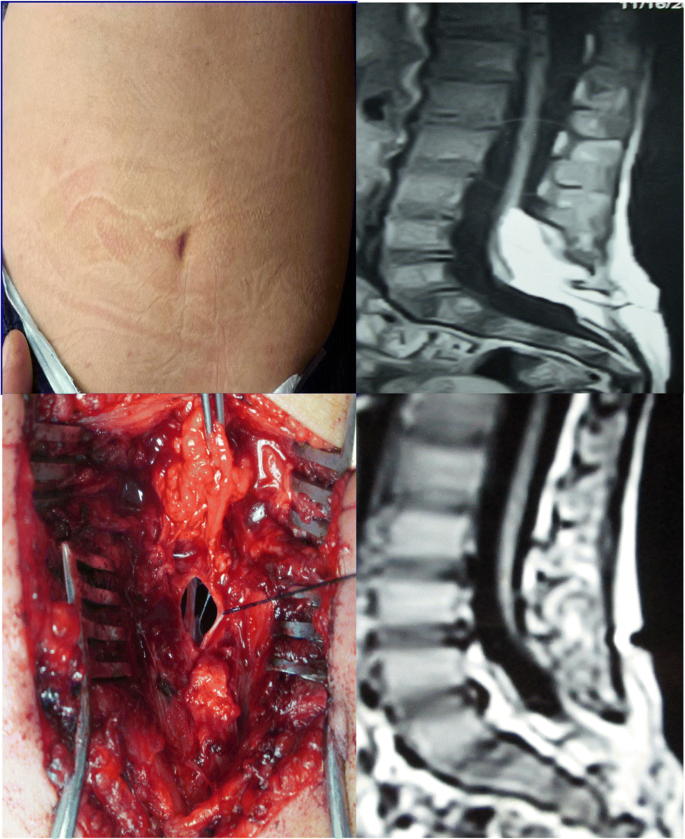
Male patient iii years sometime. Skin dimple image, T1 MRI with cord tethering by lipoma extending intradural, and conus level at the 5th lumber vertebra. Intraoperative image showing total removal of the lipoma and after 1 year follow-up T1 MRI with conus level at lumber three–4 disc and no lipoma
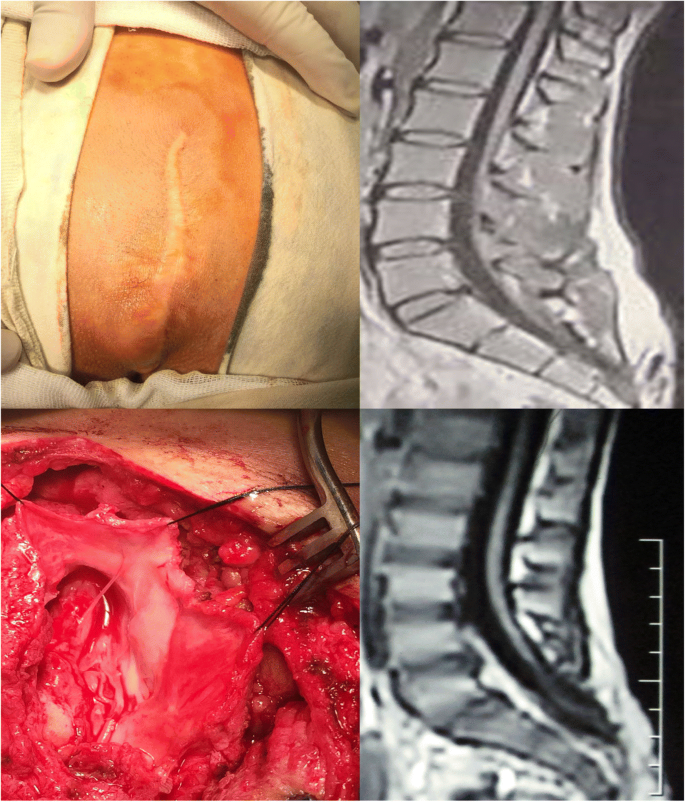
Male patient 23 years sometime with recurrent cord tethering. T1MRI preoperative conus location at the second sacral vertebra, intraoperative imaging after cord release, and 1 year postoperative T1MRI with conus level between the fifth lumbar and start sacral vertebra
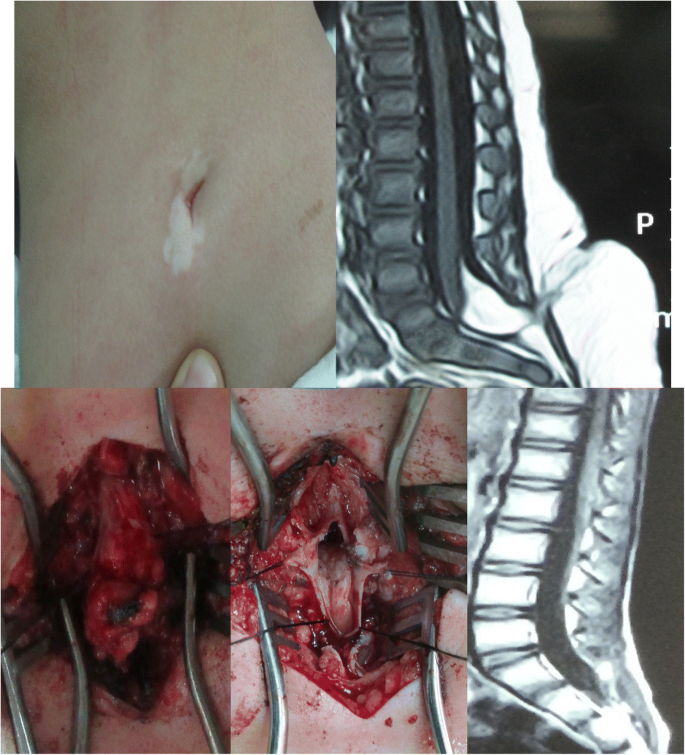
Subtotal resection of intradural lipoma in 6 years old male child with skin dimple. Preoperative T1MRI, intraoperative images, and ane year postoperative T1MRI
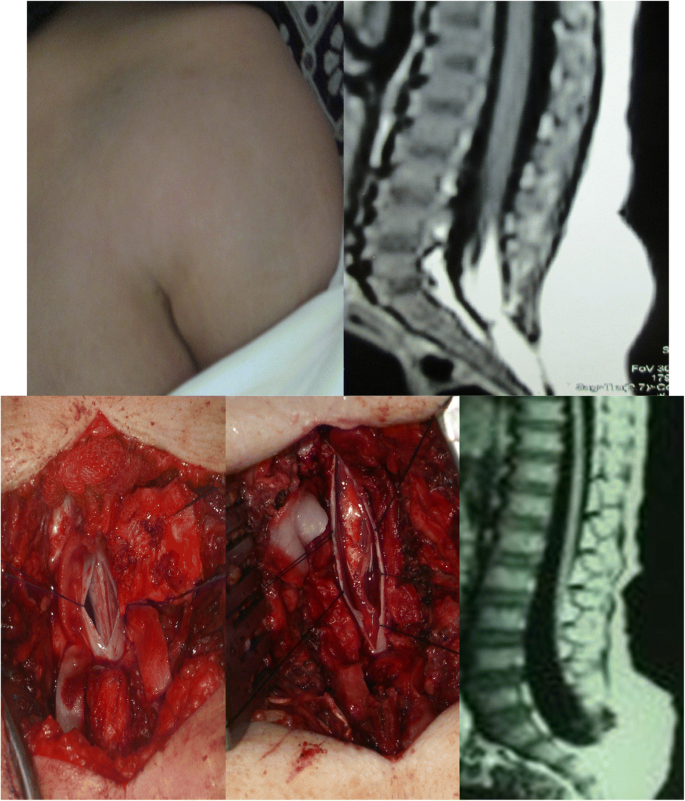
Total resection of intradural lipoma in three years onetime female child. Preoperative T1MRI, intraoperative images, and T1MRI one yr postoperative
Results
Patients of this study were 29 males and fourteen females with ratio almost 2:1, and the youngest was 2 years old and the oldest was 23 years old with a mean age of 9 years (Tables 1 and ii). Tabular array 3 shows the clinical presentation of these patients; dorsum lump was the commonest back sign. Clinical analysis of those patients peculiarly beneath 6 years onetime must exist taken with consideration of normal physiological and mental evolution as normal urine control can be considered at age 5 years, stool control at age iv years, and mental pain/parathesia differentiation at 6 years quondam. Imaging and urodynamic studies of our patients (Tabular array 4) show spina bifida in 33/43 (77%) patients, lipoma in 20/43 (71%) patients, and conus location at L5 in 35% of the patients. Urodynamic studies testify neurogenic bladder abnormalities in all examined patients (15/15, 100%). Microscopic untethering was done for all patients under full general anesthesia with operative findings in Tabular array 5 and surgical procedures in Table half dozen. Intraoperative adhesions were found in 36/43 (84%) patients and released in all patients. Thickened filum terminale was institute in 28/43 (65%) patients and sectioned in all patients. Postoperative complications were cerebrospinal fluid (CSF) leak in vii patients, of them two patients needed secondary sutures and 2 patients suffered wound infection and treated conservatively (Table vii). Subsequently 1 year follow-upward, in that location were significant improvements in children compared to adults regarding parathesia, lower limb weakness, urinary abnormalities, and bowel abnormalities (Table 8). Tables 9 and x show the meaning role of filum sectioning and absence of lipoma in clinical improvement in those patients. Urodynamic study improvements were noted in eleven/xv (73%) patients, lipoma size decreased in all affected patients, and conus location changed in only 7% patients at 1 year follow-upwardly (Table 11). Demonstrative cases shown in (Figs. 1, 2, 3, 4, and 5).
Discussion
Most series on tethered cord syndrome showed female person predominance [3, four], while our study showed male predominance (67%).
Tethered cord syndrome is mostly noted in children. At that place were 23 adult patients versus fifty children with tethered cord treated in Sofuoglu et al. [three] report. In our written report, there were 33 children and the 10 developed patients.
Clinical manifestations of TCS differ among patients specially children and adults. The symptoms and signs may be noted since birth or announced afterward on with body growth as the spines elongate and stretch-induced functional disorders of the spinal cord and roots occur. Clinical manifestations of children in this study were back lump in 70%, pare dimple in 9%, back pain and parathesia from the age of vi years erstwhile in 100% and 67% respectively, lower limb weakness in 61%, urine abnormalities from the of age five years in 75%, and bowel abnormalities from the historic period of four years in 65%. The study of Yelikbayev and Tutayeva [v] on 30 children aged 2–eighteen years reported weakness in 87%, impaired functions of pelvic organs in ninety%, and peel manifestations in 77%. Khoshhal et al. [two] study on 35 patients anile 2 months to 11 years plant that the most frequent dysraphism was lipomeningomylocele (34.3%) followed by myelomeningocele (22.8%) and dermal sinus (14.3%). Back lump was presented in 65.7%, and neurological harm in 68.4% of 2 years or older.
Developed patients in this written report presented with urine abnormalities in 100%, bowel abnormalities in eighty%, back pain in lxxx%, lower limbs weakness in 60%, and dorsum lump in 50% of the patients. Gao et al. [6] study on 82 adult tethered cord patients found depression back pain in 83%, weakness in 71%, sensory dysfunction in 54%, and defecation dysfunction in 50%. Sofuoglu et al. [3] reported clinical manifestations of developed tethered string equally 65.2% back pain, 52.2% bladder dysfunction, 17.iv% fecal incontinence, 52.2% weakness, 21.7% numbness, and 61% back swelling.
MRI, plain X-ray of the spine, and urodynamic studies are of great value for diagnosis and management of tethered string syndrome. Nosotros institute spina bifida in 33 (77%) patients, lipoma in 20 (47%) patients, dermoid in 3 (7%) patients, conus level at L5 in 15 (35%) patients, and urodynamic studies were impaired in all study cases, mostly hyper-reflexic bladder (67%). Sofuoglu et al. [3] noted in their study on 23 adult patients the commonest conus level was L5 (34.8%), lipoma in 37%, and dermal sinus in 21.vii%. Gupta et al. [7] mentioned that the most frequent MRI finding was a low lying spinal cord with intradural and/or extradural lipoma. Yelikbayev and Tutayeva [v] report on children noted hyper-reflexic bladder is oftentimes marked, and they considered the tethered cord syndrome as the crusade of neurogenic hyper-reflexic bladder even the conus at normal level without filum terminalis changes. In eighteen–54% of TCS patients, the conus lies at normal level, and diagnosis by dynamic MRI of the spine shows effort-induced symptoms [eight, 9], but this not found in our study. Also, conus level varied between studies every bit Valentini et al. [x] reported L2–L3 level in 50% of patients.
Microscopical treatment was done for all patients dealing of the offending pathologies.
Cerebrospinal fluid leak occurred in eight patients (xix%), two of them needed 2ry sutures. Wound infection occurred in two cases and five% were treated conservatively. Duz et al. [11] reported 5% CSF leak, and no infections in 22 patients. Sofuoglu et al. [3] reported CSF leak in iii patients and wound infection in iii patients (thirteen%). Rajpal et al. [12] reported 3/61 patients suffered wound infection, ane patient suffered CSF leak, two patients suffered pseudomeningocele, and one patient suffered astute respiratory distress syndrome. Iskandar et al [xiii] reported one CSF leak and five pseudomeningocele in their report on 34 patients.
Clinical comeback 1 year after surgery in our study showed back pain comeback in 60% of children and 75% of adults, parathesia improved in 60% of children and 30% of adults, weakness improved in 40% of children and 17% of adults, urine abnormalities improved in 60% of children and xxx% of adults, and bowel abnormalities improved in 47% of children and 25% of adult patients. Children in our report showed significant comeback regarding all symptoms except back pain in comparing with adults. Intraoperative filum sectioning showed significant comeback of patient symptoms except back pain, and absence of lipoma showed significant improvement in weakness. Review of literatures suggests that the tethered cord syndrome reversible symptoms are due to metabolic derangement and alterations in oxidative metabolism. Persistent symptoms may vary depending on severity and duration at presentation [8]. Iskandar et al. [13] constitute improvement in adults, 81.five% back pain, 43.1% motor or sensory dysfunctions, and 61.1% bowel and bladder disturbance. Sofuoglu et al. [3] reported 50% improvement in back pain, 66.seven% motor weakness improvement, and 75% bladder and bowel comeback in adults. Lee et al. [1] found improvements in 78% back pain, 83% leg pain, 64% motor weakness, and fifty% urological abnormalities. Duz et al. [11] reported back pain improvement in 57.1% and bladder dysfunction in 66.half dozen%, and two patients with fecal incontinence did not ameliorate. Rajpal et al. [12] reported back pain improved in 65% and bowel/bladder dysfunctions in 62%. Solmaz et al. [xiv] reported urological improvement in 21 patients (20%) and back pain improved in all patients on their study on 49 children. In Bowman et al. [15] written report on children with myelomeningocele for untethering, the pain improved in 100%, and seventy% showed improvement in lower extremities and 64% in bladder dysfunctions. Haro et al. [sixteen] reported that adults showed better comeback in neurological and urinary bug than natal or juvenile onset tethered cord syndrome. Seki et al. [17] mentioned that age at surgery is not significantly associated with prognosis. Tethered cord syndrome may take dissimilar curative effect after surgery according to the cause. Removal of the thickened filum can get better results [six]. Recurrent surgeries and presence of lipoma had higher incidence of failed detethering [x]. Also, Selden et al. [18] found significant improvement with filum sectioning. These data agree with our results.
Conus location detected by MRI on follow-upwardly found to be on the same location equally preoperative MRI in 77% of the patients in our written report, and urodynamic studies showed comeback in 73% of the studied patients. Postoperative MRI has no part for evaluation of skillful detethering merely simply clinical and urodynamic evaluation. Even the presence of lipoma residual is non significantly associated with retethering [19]. Kearns et al. [twenty] found 44% comeback in urodynamic studies on 34 children afterwards tethered cord repair and mentioned that a review of five series showed improvement in 11.one–54.v% afterwards untethering, merely none of their patients or other studies became urologically normal every bit the conus and roots were inevitably exposed to some injuries, also documented by [21, 22]. Improvement of urological symptoms or urodynamic finding reported to be 38% and 100% respectively by Vernet et al. [23] and Flanigan et al. [24].
Conclusion
Clinical presentation of tethered cord syndrome differs co-ordinate to underlying pathology and historic period of the patients. There were improvements in patient weather in all studies with few controllable complications. Surgical treatment is beneficial in most patients, and childhood intervention is amend than adulthood. Postoperative MRI findings non necessarily correlate with surgical effect but clinical and urodynamic studies are the all-time predictors.
Written report limitations
- 1.
The causes of tethered string syndrome are so much and in need for a bigger number of cases for evaluation.
- 2.
The follow-upwards evaluation was 1 twelvemonth simply, which is a short period.
Abbreviations
- CSF:
-
Cerebrospinal fluid
- MRI:
-
Magnetic resonance imaging
- TCS:
-
Tethered cord syndrome
References
-
Lee GY, Paradiso G, Totor CH, Gentili F, Massicotte EM, Fehlings MG. Surgical management of tethered cord syndrome in adults: indications, techniques, and long-term result in 60 patients. J Neurosurg Spine. 2006;4(2):123–31.
-
Khoshhal KI, ABOS MWR, Elgamal EA, Salih MAM. Tethered cord syndrome: a report of 35 patients. J Taibah University Med Sci. 2012;7(1):23–8.
-
Sofuoglu OE, Abdullah A, Emel Eastward, Guler B. Management of tethered cord syndrome in adults: experience of 23 cases. Turk Neurosurg. 2017;27(2):226–36.
-
Klekamp J. Tethered cord syndrome in adults. J Neurosurg Spine. 2011;15:258–70.
-
Yelikbayev GM, Tutayeva AA. Clinical manifestation of a tethered cord syndrome at children, and enquiry methods for early diagnosis of disease. Biomed Pharmacol J. 2015;8(ii):597–601.
-
Gao J, Kong X, Li Z, Wang T, Li Y. Surgical handling on developed tethered cord syndrome. A retrospective written report. Medicine. 2017;96(32):e7808.
-
Gupta SK, Khosla VK, Sharma BS, Mathuriya SN, Pathak A, Tewari MK. Tethered cord syndrome in adults. Surg Neurol. 1999;52(4):362–70.
-
Yamada S, Won DJ, Siddiqi J, Yamada SM. Tethered string syndrome: overview of diagnosis, and treatment. Neurol Res. 2004;26:719–21.
-
Warder DE, Oakes WJ. Tethered string syndrome: the low lying, and unremarkably positioned conus. Neurosurg. 1994;34:597–600.
-
Valentini LG, Selvaggio Thou, Visintini S, Erbetta A, Scaioli V, Solero CL. Tethered string: natural history, surgical outcome, and risk for Chiari malformation 1 (CM1). Neurol Sci. 2011;32(3):353–6.
-
Duz B, Gocmen S, Secer Hullo, Basal S, Gonul Eastward. Tethered string syndrome in adulthood. J Spinal Cord Med. 2008;31(iii):272–viii.
-
Rajpal S, Tubbs RS, George T, Oakes WJ, Fuchs HE, Hadley MN, Iskander BJ. Tethered cord due to spina bifida occulta presenting in machismo: a tricenter review of 61 patients. J Neurosurg Spine. 2007;six(3):210–5.
-
Iskandar BJ, Flumer BB, Hadley MN, Oakes WJ. Congenital tethered spinal cord syndrome in adults. Neurosurg Focus. 2001;10(1):e71–5.
-
Solmaz I, Izci Y, Albayrak B, Cetinalp E, Kural C, Sengul G, Gocmez C, Pausal Due south, Tuzun Y. Tethered cord syndrome in childhood: special emphasis on the surgical technique, and review of the literature with our feel. Turk Neurosurg. 2011;21(4):516–21.
-
Bowman RM, Mohan A, Itot J, Mclone DJ. Tethered cord release: a long-term study in114 patients: clinical article. J Neurosurg Pediatr. 2009;iii(iii):181–vii.
-
Haro H, Komori H, Okawa A, Kawabata S, Shinomiya K. Long-term consequence of surgical treatment for tethered cord syndrome. J Spinal Disord Tech. 2004;17(1):xvi–20.
-
Seki T, Hida K, Yano Southward, Sasamori T, Hamauch Due south, Koyanagi I, Houkin Thousand. Surgical outcome of children, and adolescents with tethered cord syndrome. Asian Spine J. 2016;10(5):940–4.
-
Selden NR, Nixon RR, Skoog SR, Lashley DB. Minimal tethered cord syndrome associated with thickening of the last filum. J Neurosurg. 2006;105(3):214–eight.
-
Schoenmakers MA, Gooskens RH, Gulmans VA, Hanlo Pow, Vandertop WP, Uiterwaal CS, Helders PJ. Long-term consequence of neurosurgical untethering on neurosegmental motor and airing levels. Dev Med Kid Neurol. 2003;45:551–v.
-
Kearns JT, Esposito D, Dooley B, Frim D, Guandeti MS. Urodynamic studies in spinal cord tethering. Childs Nerv Syst. 2013;29:1589–600.
-
Gross AJ, Michael T, Godeman F, Weigel K, Huland H. Urological finding in patients with neurosurgically treated tethered spinal cord. J Urol. 1993;149:1510–1.
-
Paradiso G, Lee GY, Sarjeant R, Fehlings MG. Multi-modality neurophysiological monitoring during surgery for adult tethered cord syndrome. J Clin Neurosci. 2005;12(93):935–seven.
-
Vernet O, Farmer JP, Houle AM, Montes JL. Impact of urodynamic studies on the surgical direction of the spinal cord tethering. J Neurosurg. 1996;85:555–9.
-
Flanigan RC, Russel DP, Walsh JW. Urologic aspect of tethered string. Urology. 1989;33:80–3.
Acknowledgements
Not applicable.
Funding
No funding was received for this written report.
Availability of data and materials
All data that support the findings of this study are bachelor from the neurosurgery department Zagazig university hospital. Data are however available from the authors when requested with permission.
Author information
Affiliations
Contributions
WAAE, AKAA, and SHM contributed to the report conception, blueprint, and surgical works. WAAE collected data and drafted the manuscript. All authors read and approved the terminal manuscript.
Corresponding author
Ethics declarations
Ethics blessing and consent to participate
A written consents were obtained for all patients ( from the patient and from the parent when age below 16 years old ), and the study approved past Zagazig university institutional review board (Zu-IRB) on 15/three/ 2013.
Consent for publication
A written consents for publication from the patients and from parents when the age below 16 years one-time were attained.
Competing interests
The authors declare that they have no competing interests.
Publisher's Note
Springer Nature remains neutral with regard to jurisdictional claims in published maps and institutional affiliations.
Rights and permissions
Open Admission This article is distributed under the terms of the Creative Commons Attribution four.0 International License (http://creativecommons.org/licenses/by/four.0/), which permits unrestricted use, distribution, and reproduction in whatsoever medium, provided you give advisable credit to the original author(s) and the source, provide a link to the Artistic Commons license, and bespeak if changes were made.
Reprints and Permissions
About this commodity
Cite this commodity
Elmesallamy, W., AbdAlwanis, A. & Mohamed, S. Tethered cord syndrome: surgical outcome of 43 cases and review of literatures. Arab republic of egypt J Neurosurg 34, 4 (2019). https://doi.org/ten.1186/s41984-019-0029-8
-
Received:
-
Accustomed:
-
Published:
-
DOI : https://doi.org/x.1186/s41984-019-0029-8
Keywords
- Tethered cord
- Urodynamic written report
- Microscopic surgery
Source: https://ejns.springeropen.com/articles/10.1186/s41984-019-0029-8
0 Response to "Tethered Cord Due to Spina Bifida Occulta Presenting in Adulthood a Tricenter Review of 61 Patients"
Post a Comment